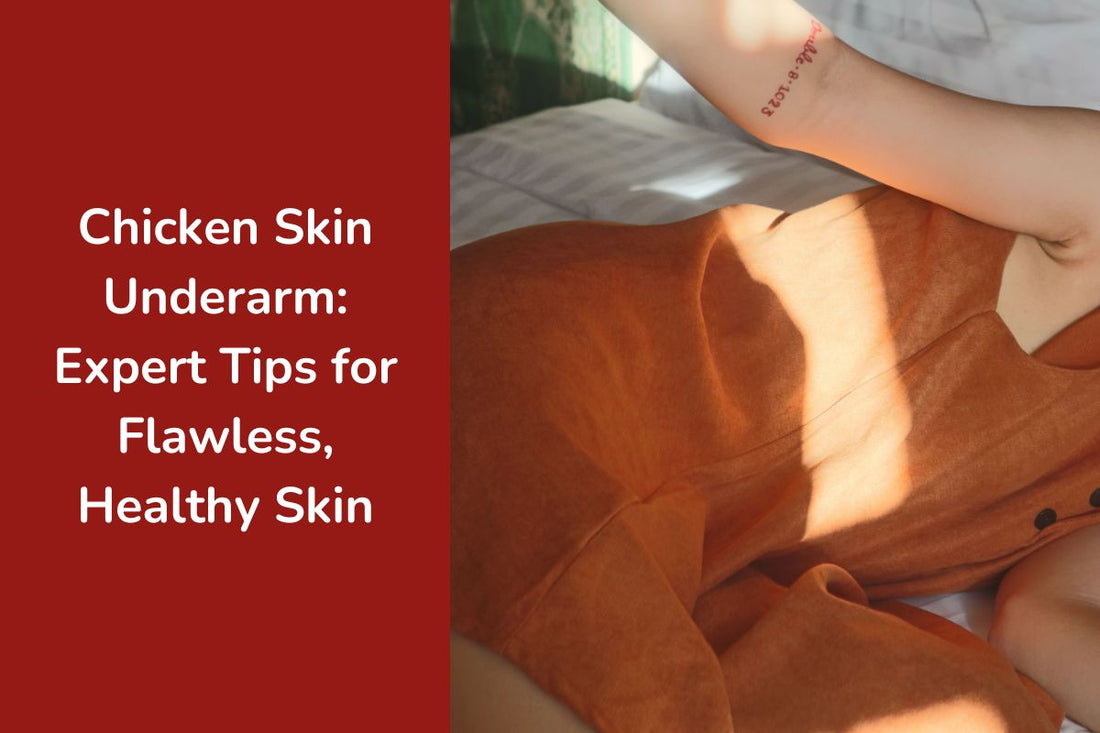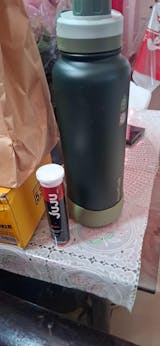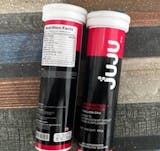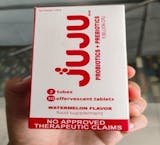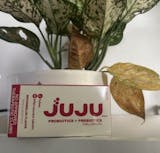Excess skin and pigmentation around the underarm area can be a source of embarrassment and discomfort for many people.
One common condition that affects this area is chicken skin underarm, which refers to the appearance of small bumps or rough patches on the skin. These bumps are usually caused by the buildup of dead skin cells and can be aggravated by factors such as shaving, friction, and certain skin conditions.
Fortunately, there are various treatments and remedies available to help alleviate the symptoms of chicken skin underarm and improve the overall appearance and texture of the skin in this area.
In this article, we will explore the causes of chicken skin underarm, as well as some effective solutions for managing this condition.
IN THIS ARTICLE
10. Conclusion
What is Chicken Skin Underarm?
Keratosis pilaris (sometimes called “chicken skin”) is a common skin condition. It happens when a protein called keratin plugs the hair follicles, causing white or reddish bumps on the skin. The tiny bumps can feel dry and rough like sandpaper. Keratosis pilaris (pronounced:
care-uh-TOE-siss pill-AIR-iss) most often is on the upper arms, thighs, cheeks, and buttocks.
Like acne, keratosis pilaris is a lot more common around puberty. Often, it gets better as a person grows older. It also tends to come and go. It usually gets worse in winter.
Keratosis pilaris is genetic. So if you have it, chances are a family member has it too (or had it when they were younger). It’s not an infection, though, and it’s not contagious.
Keratosis pilaris is not a health problem. Although it doesn’t hurt or itch, some people feel embarrassed about it. You probably notice it more than other people do.
Here are some things you can try to make keratosis pilaris look better:
- Use a mild, non-soap cleanser on your upper arms when you shower or bathe.
- Avoid hot baths or showers.
- Apply a mild over-the-counter moisturizer several times during the day. Moisturizers containing lactic acid or salicylic acid can help soften bumps and decrease roughness.
If you’re not sure what product to choose, ask your doctor or dermatologist to recommend brands of cleansers or moisturizers that might work for you.
If your skin doesn’t get better after following a simple cleansing and moisturizing regimen, talk to your doctor.
CAUSES OF CHICKEN SKIN UNDERARM
Chicken skin underarm, also known as keratosis pilaris, is a common skin condition that affects many individuals. There are several factors that can contribute to the development of chicken skin underarm, including genetic predisposition, hormonal imbalances, dry skin, allergies and sensitivities, improper hair removal techniques, excessive sweating, nutrient deficiencies, skin inflammation, excess keratin production, and environmental factors.
Genetic Predisposition
Genetic predisposition is a common cause of keratosis pilaris, which is also known as chicken skin underarm. People who have a family history of keratosis pilaris or inherited skin type and conditions are more likely to develop this condition. The condition occurs when too much keratin builds up in the hair follicles, causing small, raised bumps to appear on the skin. While there is no cure for keratosis pilaris, it can be managed with appropriate skincare and lifestyle changes. It is essential to consult with a dermatologist for proper diagnosis and treatment recommendations.
Hormonal Imbalances
Hormonal imbalances can also contribute to the development of chicken skin underarm, also known as keratosis pilaris. Puberty and hormonal fluctuations during adolescence can trigger the overproduction of keratin, leading to the formation of small bumps on the skin. Additionally, pregnancy-related skin changes can also cause hormonal imbalances, leading to the development of keratosis pilaris. While these hormonal imbalances can be challenging to control, certain lifestyle changes such as maintaining a healthy diet, exercising regularly, and managing stress levels can help manage the symptoms of chicken skin underarm. Additionally, topical treatments such as moisturizers, exfoliants, and prescription medications can also be recommended by a dermatologist to help manage the condition.
Dry skin
Dry skin is another common cause of chicken skin underarm, or keratosis pilaris. A lack of skin hydration and exposure to harsh weather conditions such as cold or dry air can cause the skin to become dry and flaky, leading to the development of small, raised bumps. It is essential to keep the skin moisturized by using emollients, avoiding hot showers or baths, and wearing protective clothing in harsh weather conditions. Additionally, avoiding harsh soaps and using mild cleansers can also help prevent further skin dryness and irritation. In severe cases, a dermatologist may recommend prescription-strength creams or ointments to manage the symptoms of chicken skin underarm.
Allergies and Sensitivities
Allergies and sensitivities can also contribute to the development of chicken skin underarm, or keratosis pilaris. People may experience reactions to certain fabrics or laundry detergents that can irritate the skin and trigger the formation of small, raised bumps. Food allergies can also affect the skin and lead to the development of chicken skin underarm. It is essential to identify and avoid allergens that may be contributing to the condition, such as changing laundry detergents or avoiding certain fabrics. A dermatologist can perform patch testing to identify specific allergens and recommend appropriate treatment options. In some cases, avoiding certain foods that trigger an allergic reaction may also help manage the symptoms of chicken skin underarm.
Improper Hair Removal Techniques
Improper hair removal techniques can also contribute to the development of chicken skin underarm, or keratosis pilaris. Shaving with dull razors can lead to ingrown hairs and cause irritation, which can worsen the symptoms of keratosis pilaris. Waxing or plucking can also irritate the skin and cause inflammation, leading to the formation of small, raised bumps. It is essential to use proper hair removal techniques to manage this condition and reduce the risk of further irritation. Using a sharp razor and shaving in the direction of hair growth can help prevent ingrown hairs and reduce irritation. For those who prefer waxing or plucking, it is essential to ensure that the skin is properly prepared and that the hair is removed in the direction of hair growth to reduce the risk of irritation. Additionally, using gentle, non-irritating skincare products before and after hair removal can help soothe the skin and reduce inflammation, further managing the symptoms of chicken skin underarm.
Excessive Sweating
Excessive sweating, also known as hyperhidrosis, can contribute to the development of chicken skin underarm, or keratosis pilaris. Sweating can cause the skin to become moist, which can lead to the formation of small, raised bumps. Tight or non-breathable clothing can also contribute to this condition by trapping sweat against the skin, leading to irritation and the formation of chicken skin underarm. It is essential to wear loose, breathable clothing to allow the skin to breathe and reduce the risk of developing keratosis pilaris. In severe cases, a dermatologist may recommend prescription-strength antiperspirants or other treatment options to manage excessive sweating and reduce the symptoms of chicken skin underarm.
Nutrient Deficiencies
Nutrient deficiencies can also contribute to the development of chicken skin underarm, or keratosis pilaris. A lack of essential nutrients such as vitamin A, E, or essential fatty acids can lead to dry, rough skin, and the formation of small, raised bumps. Poor diet and nutrition can also contribute to this condition by depriving the skin of essential nutrients necessary for healthy skin. It is essential to maintain a healthy, balanced diet rich in vitamins, minerals, and essential fatty acids to promote healthy skin and reduce the risk of developing keratosis pilaris. In some cases, a dermatologist may recommend vitamin supplements or topical treatments to manage the symptoms of chicken skin underarm.
Skin Inflammation
Skin inflammation, such as dermatitis or eczema, can also contribute to the development of chicken skin underarm, or keratosis pilaris. Inflammatory skin conditions can cause the skin to become dry, itchy, and irritated, leading to the formation of small, raised bumps. Excess keratin production can also contribute to this condition by clogging hair follicles and leading to the formation of chicken skin underarm. It is essential to manage underlying skin conditions such as dermatitis or eczema to reduce the risk of developing keratosis pilaris. A dermatologist may recommend topical treatments or prescription medications to manage inflammation and reduce the symptoms of chicken skin underarm. Exfoliating the affected area and using moisturizers regularly can also help manage this condition.
Excess Keratin Production
Excess keratin production is a primary cause of chicken skin underarm, or keratosis pilaris. This condition occurs when there is an overproduction of keratin protein, which can lead to the formation of small, raised bumps. Blocked hair follicles can also contribute to the development of chicken skin underarm by trapping excess keratin and causing inflammation. It is essential to manage this condition by exfoliating the affected area regularly to remove excess keratin and prevent hair follicles from becoming blocked. Moisturizing the skin can also help manage the symptoms of keratosis pilaris by reducing dryness and promoting healthy skin. In severe cases, a dermatologist may recommend topical treatments or prescription medications to manage this condition and reduce the appearance of chicken skin underarm.
Environmental Factors
Environmental factors can also contribute to the development of chicken skin underarm, or keratosis pilaris. Exposure to pollution and other environmental toxins can irritate the skin and lead to inflammation, which can worsen the symptoms of keratosis pilaris. Using harsh skincare products, such as those containing harsh chemicals or abrasive ingredients, can also irritate the skin and contribute to the development of chicken skin underarm. It is essential to use gentle, non-irritating skincare products to manage this condition and reduce the risk of further irritation. For example, Juju products are a popular brand that offers gentle, natural skincare products specifically designed to help manage keratosis pilaris. Using these products can help soothe the skin and reduce the appearance of chicken skin underarm, while also promoting healthy, hydrated skin.
How to Treat Chicken Skin Underarm
Treating chicken skin underarm, or keratosis pilaris, typically involves a combination of skincare routines, home remedies, and medical treatments.
Skincare routine is an essential part of treating chicken skin underarm. Gentle exfoliation with a mild scrub can help remove dead skin cells and reduce the appearance of bumps. Moisturizing the skin regularly can also help improve hydration levels and reduce the symptoms of dryness and roughness associated with chicken skin underarm. Avoiding harsh soaps or skincare products that can irritate the skin is also essential to prevent further irritation.
Home remedies can also be effective in managing chicken skin underarm. For instance, applying coconut oil or olive oil to the affected area can help soothe and moisturize the skin. Other home remedies include using natural remedies like oatmeal, honey, or aloe vera gel to reduce inflammation and irritation.
In more severe cases, medical treatments may be necessary to manage chicken skin underarm. These treatments may include prescription-strength topical creams or ointments that contain alpha hydroxy acids, salicylic acid, or retinoids to help exfoliate the skin and reduce inflammation. In some cases, laser therapy or intense pulsed light therapy may be used to reduce the appearance of chicken skin underarm.
Treating chicken skin underarm involves a combination of skincare routine, home remedies, and medical treatments. A gentle skincare routine that includes exfoliation and moisturizing is crucial to manage this condition.
Home remedies like coconut oil, oatmeal, honey, or aloe vera gel can also be helpful in reducing inflammation and irritation. In more severe cases, medical treatments like prescription-strength topical creams or laser therapy may be necessary to manage chicken skin underarm effectively.
Skincare Products for Chicken Skin Underarm
The below products were recommended to us by the dermatologists we spoke to. Several of our editors have also tried many of the below products.
1. CeraVe SA Lotion For Rough & Bumpy Skin
The dermatologists we spoke to all recommended the CeraVe SA Lotion to help reduce symptoms of keratosis pilaris. Cameron said he often recommends this cream to his patients due to its exfoliating and moisturizing benefits, and Sami noted it’s a great over-the-counter salicylic acid and lactic acid treatment that’s readily available.
2. AmLactin Daily Moisturizing Lotion
AmLactin is another expert-favorite product that has12% lactic acid to gently exfoliate the skin. “It has the benefit of having both an exfoliating component and serving as a daily moisturizer,” Garshick said.
Bordone noted it can help skin cell turnover and reduce the spiky texture associated with keratosis pilaris. AmLactin Daily Moisturizing Lotion has a non-greasy, fragrance-free and paraben-free formula, and it’s suitable to use as a face moisturizer, hand lotion or body lotion, the brand says.
3. First Aid Beauty KP Bump Eraser Body Scrub
If you prefer a more physical exfoliant, this body scrub from First Aid Beauty has exfoliating particles that can help remove dead cells. “It’s great because it has glycolic acid and other exfoliating acids that can be helpful,” Farber said.
It contains 10% AHAs, which the brand says can help improve the skin’s texture and smooth away bumps and roughness. First Aid Beauty recommends gently massaging the product on wet skin and using 1-2 times per week, as tolerated.
4. Eucerin Roughness Relief Cream
Cameron recommended the Eucerin Roughness Relief Cream for those with keratosis pilaris to help “minimize the appearance [of bumps] and smooth out the texture.” The cream is formulated with urea, ceramides and sunflower seed oil to help lock-in moisture for up to 48 hours, according to the brand. It’s fragrance-free and suitable for daily use on sensitive skin, Eucerin says.
5. Ebanel 40% Urea Cream
Experts told us that a urea cream is a great option to treat and prevent dry, rough and scaly skin. “If somebody wants to be a little bit more aggressive with their treatment, then they can add urea to their regimen,” Sami said.
This option from Ebanel has 40% urea — the highest potency, though Sami noted a lower concentration works just as well — and it’s formulated with 2% salicylic acid that can provide gentle exfoliation while also moisturizing, softening and smoothing out the skin.
The cream is hypoallergenic, fragrance-free and can reduce redness and inflammation thanks to ingredients like aloe vera, coconut oil and green tea leaf extract, according to the brand.
6. Gold Bond Rough & Bumpy Skin Daily Therapy Cream
Another recommendation from Cameron, the Gold Bond Rough & Bumpy Daily Therapy Cream is formulated with salicylic acid and lactic acid to gently exfoliate rough skin, as well as a combination of moisturizing ingredients to keep the skin hydrated. It has a fragrance-free, hypoallergenic formula that can be used as often as needed, according to the brand.
7. CeraVe Moisturizing Cream
Sami recommended moisturizing your skin with a cream moisturizer like this option from CeraVe, which can help the skin stay hydrated longer and reduce symptoms of dryness and itchiness in cooler climates.
The CeraVe Moisturizing Cream is a mild, fragrance-free moisturizer that contains ceramide to help restore and maintain the skin’s natural moisture barrier, according to the brand. CeraVe says the moisturizer can provide up to 24 hours of hydration and is suitable for all skin types.
Prevention and Home Remedies
Prevention and Home Remedies for chicken skin underarm can be helpful in managing the condition. Proper exfoliation techniques can help remove dead skin cells that clog pores and lead to the formation of bumps. When exfoliating, use gentle circular motions and avoid using harsh scrubs that can irritate the skin.
Keeping the underarm area hydrated is also essential in preventing chicken skin. Drinking plenty of water and using a hydrating lotion or cream can help keep the skin soft and supple. Avoid using products that contain alcohol, which can dry out the skin.
Incorporating foods rich in vitamins A, E, and essential fatty acids into your diet can also improve the health of your skin. These nutrients can be found in foods such as avocados, nuts, seeds, and leafy green vegetables.
Choosing the right hair removal method can also help prevent chicken skin. Shaving with a sharp razor and using shaving cream can help prevent irritation, while waxing and plucking can be more irritating to the skin. Laser hair removal can also be a more permanent solution, but it can be expensive.
Overall, taking care of your skin and keeping it moisturized can help prevent chicken skin underarm. If home remedies are not effective, consulting a dermatologist for medical treatment options can be helpful.
Medical Treatments and Procedures
If at-home remedies and over-the-counter products are not effective in treating chicken skin underarm, it may be time to seek medical advice. A dermatologist can recommend professional exfoliation treatments, such as microdermabrasion or chemical peels, which can help to remove dead skin cells and improve the texture and appearance of the skin.
Laser therapy is another option that can be effective in reducing the appearance of chicken skin underarm. In some cases, prescription creams or medications may be necessary to treat underlying skin conditions, such as eczema or dermatitis, that are causing the chicken skin. It’s important to consult a dermatologist before attempting any medical treatments or procedures to ensure they are safe and appropriate for your skin type and condition.
Lifestyle Changes for Healthier Underarm Skin
Proper hygiene and a consistent skincare routine are essential for healthy underarm skin. It’s important to choose clothing made of breathable fabrics that don’t irritate the skin, and to avoid tight-fitting clothes.
Stress management is also crucial, as stress can worsen skin conditions such as keratosis pilaris. When treating chicken skin underarm, it’s important to balance skin-whitening goals with proper treatment.
This means avoiding harsh and potentially harmful skin-whitening products and focusing on products that improve skin health overall. Additionally, a diet that is rich in nutrients such as vitamins A, E, and essential fatty acids can help improve skin health and prevent chicken skin underarm. Overall, making these lifestyle changes can help reduce the occurrence of chicken skin underarm and promote healthier, smoother skin.
Tips for Managing Chicken Skin Underarm
The good news is, there are things we can do to treat the condition and keep it under control. Namely, avoid triggers like heat and overly-fragranced products. As for smoothing down bumps, exfoliation can make a real difference. “Chicken skin is fairly easy to treat with the correct knowledge,” Rather than harsh scrubs, try lightly massaging your skin with a washcloth of gentle exfoliating mitt instead. Or try a chemical exfoliator like glycolic acid, lactic acid or salicylic acid.
Dealing with chicken skin underarm can be frustrating, and it may cause embarrassment and anxiety in some individuals. Coping mechanisms for this condition include focusing on self-care and building self-esteem.
Tips for managing chicken skin underarm include avoiding scratching or picking at the affected area to prevent scarring, wearing breathable clothing to avoid irritation, and using moisturizers regularly to soothe itching and prevent dryness.
Additionally, seeking support from loved ones or a therapist can help individuals manage the emotional impact of the condition. It’s important to remember that chicken skin underarm is a common and treatable condition, and seeking appropriate medical treatment and practicing good self-care can help individuals manage the condition and feel more confident in their skin.
Frequently Asked Questions
Is Chicken Skin Underarm Contagious?
No, chicken skin underarm is not contagious. It is a common skin condition that affects many people, and it is not caused by any type of infection or bacteria. It is simply a result of excess keratin buildup in hair follicles, which can lead to rough, bumpy skin on the underarms.
Can Chicken Skin Underarm be Permanent?
Chicken skin underarm is a chronic condition that can last for years or even a lifetime. While it is not harmful to your health, it can be a cosmetic concern for some people. With proper treatment and skincare routine, the appearance of chicken skin underarm can be improved, but it may never completely go away.
Does shaving or waxing worsen chicken skin underarm?
Shaving or waxing can irritate the underarm area and potentially worsen the appearance of chicken skin. It is recommended to choose hair removal methods that are gentle on the skin, such as using a sharp razor or opting for hair removal creams. It is also important to avoid over-exfoliating or scrubbing the underarm area too harshly, as this can exacerbate the condition.
How can I safely exfoliate my underarm area to reduce chicken skin?
To safely exfoliate the underarm area, it is recommended to use a gentle exfoliating scrub or a chemical exfoliant, such as alpha-hydroxy acids or salicylic acid. These can help to slough off dead skin cells and unclog hair follicles, reducing the appearance of chicken skin. It is important to avoid over-exfoliating or using harsh scrubs, as this can damage the skin.
Can I still use deodorant or antiperspirant if I have chicken skin underarm?
Yes, you can still use deodorant or antiperspirant if you have chicken skin underarm. However, it is recommended to choose products that are gentle on the skin and do not contain harsh chemicals or fragrances. Opt for natural or organic deodorants that contain ingredients such as baking soda, coconut oil, or tea tree oil, which can be less irritating to the skin.
Conclusion
When it comes to achieving flawless, healthy skin, it’s important to take a holistic approach that considers not just skincare products, but also lifestyle factors such as diet, exercise, and stress management.
By addressing all aspects of our health and well-being, we can improve the overall appearance and health of our skin, including the notoriously tricky-to-treat chicken skin underarm.
Incorporating healthy habits into our daily routine, such as staying hydrated, eating a balanced diet, and getting regular exercise, can help to promote healthy skin from the inside out.
And by choosing gentle skincare products, proper hair removal methods, and adopting a consistent exfoliation routine, we can minimize the appearance of chicken skin underarm and boost our confidence in the process.

